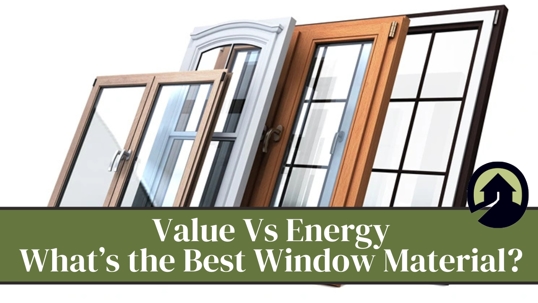When you’re investing in replacement windows, it’s easy to get caught up in glass ratings, brand names, or energy labels. But at the end of the day, your choice of window frame material plays a huge role in how much value and efficiency you actually get.
So how do you compare the options? What trade-offs should you expect between cost, performance, and curb appeal?
Let’s break it down.
Vinyl Windows: Budget-Friendly and Low Maintenance
- Pros: Affordable, weather-resistant, won’t rot or corrode. Minimal upkeep.
- Cons: Can warp or crack under extreme heat. Limited color choices. Not as durable over the long haul.
- Best For: Homeowners on a budget looking for a basic, energy-efficient upgrade without the bells and whistles.
Fiberglass Windows: Strong, Stable, and Surprisingly Efficient
- Pros: Resists warping, swelling, and temperature shifts. Extremely durable. Energy-efficient. Paintable and available in many finishes.
- Cons: Higher upfront cost than vinyl. Fewer brand options.
- Best For: Homeowners who want long-term performance, especially in hot or humid climates like Texas.
Wood-Clad Windows: Classic Beauty with Modern Protection
- Pros: Real wood interior for warmth and charm. Exterior cladding (usually aluminum or fiberglass) protects against the weather. Highly customizable.
- Cons: Most expensive option. Requires occasional interior maintenance. It can be overkill for some budgets.
- Best For: Design-forward homeowners who want the aesthetics of wood without the rot and upkeep.
So Which Window Material Is Best?
There’s no one-size-fits-all answer. The right material depends on your home’s architecture, your long-term plans, and what you’re willing to spend.
If you’re staying put and want the best value over time, fiberglass is often the sweet spot, especially in climates that might challenge other materials. If you’re moving soon, vinyl might give you enough efficiency without the upfront investment.
| Material | Cost | Efficiency | Durability | Maintenance | Best For |
|---|---|---|---|---|---|
| Vinyl | $ | ★★★☆☆ | ★★☆☆☆ | ★★★★☆ | Budget-friendly upgrades |
| Fiberglass | $$$ | ★★★★★ | ★★★★★ | ★★★★☆ | Hot, humid climates |
| Wood-Clad | $$$$ | ★★★★☆ | ★★★★☆ | ★★☆☆☆ | Premium look and feel. |
How Texas Weather Impacts Window Material Choice
If you live in Texas, you know the heat is no joke. With triple-digit temps, high humidity, and intense sun exposure, your windows need to do more than just look good; they need to hold up.
Here’s how these materials hold up if you are in the Lone Star State:
- Vinyl can become brittle or warp over time, especially on darker-colored frames exposed to direct sunlight.
- Fiberglass remains stable in extreme heat, resists expansion and contraction, and is ideal for energy efficiency in both hot summers and cold snaps.
- Wood-clad gives you that high-end look, but be cautious about unprotected wood interiors if you don’t stay on top of maintenance. Moisture and heat can take their toll.
If energy savings and long-term durability in Texas heat are your top priorities, fiberglass is often the best performer.
Need Help Choosing the Right Fit?
At Southwest Exteriors, we install all kinds of windows, and we’ll be happy to walk you through the pros and cons of each material based on your goals, budget, and home style.
Schedule a free, no-pressure consultation to get expert guidance and honest answers.
Reimagine the possibilities, without the guesswork.
Frequently Asked Questions (FAQ)
Q: What’s the most energy-efficient window frame material? A: Fiberglass generally offers the best thermal performance due to its low expansion rate and airtight fit, especially in extreme climates like Texas.
Q: Are vinyl windows bad for hot climates?
A: Not necessarily, but they can warp or fade faster in extreme sun and heat, especially dark-colored frames. Fiberglass or wood-clad options hold up better long-term.
Q: How long do fiberglass windows last?
A: Fiberglass windows can last 30-40 years or more with minimal maintenance, making them a strong long-term investment.
Q: Is it worth paying more for wood-clad windows?
A: If aesthetics and customization are your top priorities, yes. But be prepared for some upkeep on the interior wood surfaces.
Q: What window material requires the least maintenance?
A: Vinyl and fiberglass both offer low-maintenance options. Vinyl is easier to clean, while fiberglass is more durable and can be repainted if needed.
Q: Do different materials affect my home’s resale value?
A: Higher-end materials like fiberglass and wood-clad may increase perceived value, especially in design-conscious or upscale neighborhoods.

